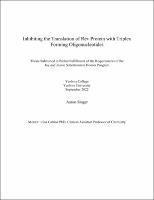Please use this identifier to cite or link to this item:
https://hdl.handle.net/20.500.12202/8465| Title: | Inhibiting the Translation of Rev Protein with Triplex Forming Oligonucleotides |
| Authors: | Catrina, Irina Singer, Aaron |
| Keywords: | human immunodeficiency virus-1 (HIV-1) infection RNA DNA |
| Issue Date: | Sep-2022 |
| Publisher: | Yeshiva University |
| Citation: | Singer, A. (2022, September). Inhibiting the Translation of Rev Protein with Triplex Forming Oligonucleotides (Undergraduate honors thesis, Yeshiva University). |
| Series/Report no.: | Jay and Jeanine Schottenstein Honors Theses;September 2022 |
| Abstract: | Despite ongoing advancements in care, patients affected by human immunodeficiency virus-1 (HIV-1) infection continue to have a shorter than average lifespan and a decreased quality of life1. Therefore, more research is still necessary to ensure better health outcomes for these patients.¶ In the early step of its replication cycle, HIV-1 enters a host cell, and reverse transcribes its RNA into DNA. The virus then integrates the reverse-transcribed DNA into the host cell’s genome using a viral integrase. The cell begins transcribing the integrated viral deoxyribonucleic acid (DNA) and producing fully spliced and processed messenger ribonucleic acids (mRNA)2. Rev protein, which itself is made from a fully spliced viral transcript, mediates the transport of intron containing viral RNAs out of the nucleus and into the cytoplasm via the CRM1 pathway. This enables the nucleocytoplasmic export of both genomic RNA (which will be packaged into virions,) and intron-containing RNA encoding for structural proteins. Rev also stabilizes viral RNAs, inhibits cellular splicing, and promotes translation of viral RNA. These functions make Rev protein essential for HIV-1’s continued survival in vivo and make it an attractive target for anti-HIV drug design3.¶ Triple helical RNA was first described in 19574 and triple helices have since been found to play a significant role in regulating gene expression5. Previous research has shown that translation of mRNA can be inhibited using triplex forming oligonucleotides (TFOs)6. TFOs are short sequences of nucleic acids that can form a triple helix with double stranded DNA or double stranded RNA, and a TFO can be composed of DNA, RNA, or peptide nucleic acid (PNA) backbone.¶ In this study, we identified a double-stranded region within the predicted Rev mRNA secondary structure(s) suitable for TFO targeting. We designed a PNA-based TFO that bound to this region. This was done using our Python program TFOFinder7. We confirmed triple helix formation using a hairpin that modeled this Rev mRNA region. Then, we used a commercial transcription/translation kit8 to transcribe Rev mRNA and test the ability of our TFO(s) to inhibit translation of the Rev protein in vitro. |
| Description: | Undergraduate honors thesis / Open access |
| URI: | https://hdl.handle.net/20.500.12202/8465 |
| Appears in Collections: | Jay and Jeanie Schottenstein Honors Student Theses |
Files in This Item:
| File | Description | Size | Format | |
|---|---|---|---|---|
| Aaron_Singer_Honors_Thesis_September_2022 OA.pdf | 1.58 MB | Adobe PDF |  View/Open |
This item is licensed under a Creative Commons License

